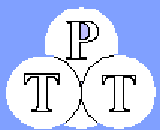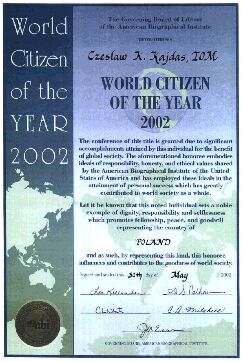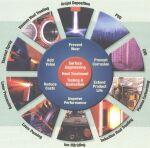
Polskiego Towarzystwa Tribologicznego
Publikacja dofinasowana przez Komitet Badań Naukowych
Nr 6/2002
 |
Biuletyn Polskiego Towarzystwa Tribologicznego Publikacja dofinasowana przez Komitet Badań Naukowych Nr 6/2002 |
TRIBOLOGIA działa na polu wymiany myśli naukowej w obszarze tarcia, zużycia i smarowania. Nasze pismo publikuje ciągle rosnącą liczbę artykułów naukowych z kraju i zagranicy. W roku 2002 opublikowano w TRIBOLOGII 145 artykułów, podczas gdy w roku poprzednim było ich 88. Objętość rocznika 2002 wyniosła 1750 stron (przy 1138 w 2001 r). Nastąpił więc poważny rozwój czasopisma, co jest wynikiem wielkiego zapotrzebowania na publikacje naukowe i techniczne z obszaru badań tarcia i zużycia.
W roku 2002 opublikowano TRIBOLOGII 20 referatów zawierających wyniki projektów badawczych i celowych finansowanych przez Komitet Badań Naukowych (w roku ubiegłym było takich prac 12). Tak więc TRIBOLOGIA jako forum wymiany myśli naukowej w obszarze funkcjonowania czasopisma nabiera coraz większego znaczenia.
Materiały prezentowane w druku są oryginalne i aktualne. Poziom merytoryczny czasopisma naukowego TRIBOLOGIA jest oceniany przez wielu ekspertów bardzo pozytywnie - i to również w zestawieniu z czasopismami międzynarodowymi. Procedura kwalifikowania artykułów do publikacji i ich recenzowanie zapewniają wysoki poziom naukowy czasopisma.
W Radzie Programowej czasopisma działa wielu uznanych uczonych zagranicznych, w tym prof. H. Peter Jost - Prezydent Międzynarodowej Rady Tribologii (International Tribology Council z siedzibą w Londynie) oraz kilku spośród kilkunastu na świecie laureatów Złotego Medalu Tribologii, będącego najwyższym wyróżnieniem tribologicznym. Miarą międzynarodowego zaangażowania TRIBOLOGII jest też liczba referatów w języku angielskim - w roku 2002 było ich 53 (wobec 6 w 2001 r.). Zatem międzynarodowe znaczenie dwumiesięcznika naukowo-technicznego TRIBOLOGIA jest coraz poważniejsze.
W roku 2002, tak jak i w poprzednich latach, TRIBOLOGIA została dofinansowana przez KBN. Uzyskane dofinansowanie zostało wykorzystane w całości. Wydano nakład wszystkich zeszytów (120 ark. wyd. tj. o 30% więcej niż planowano). Periodyk jest drukowany w formacie B5 na wysokiej jakości papierze klasy 110 g/m2 w wielobarwnych okładkach. Poszczególne zeszyty TRIBOLOGII opublikowano z wyprzedzeniem w stosunku do zaplanowanych terminów.
prof. dr hab. inż. Marek Wiśniewski
Wrocław, dnia 2.12.02.
prof. dr hab. inż. Ryszard CZARNY
Organizatorem Sympozjum było:
W Miedzynarodowej Radzie Naukowej byli profesorowie:
Strone finansową Sympozjum prowadziło Polskie Towarzystwo Tribologiczne, które dostało dofinansowanie z Komitetu Badan Naukowych.
Sympozjum INSYCONT'02 odbyło sie w Krakowie w dniach 19-21 wrzeonia 2002 roku. Miejscem Sympozjum oraz Wystawy, która była w czasie Sympozjum, były pomieszczenia Akademii Górniczo-Hutniczej.
Tematyka Sympozjum : New Achievements in Tribology
Referaty Sympozjum były recenzowane i w zależności od poziomu naukowego wydane drukiem w nastepujących wydawnictwach:
Referaty wygłaszane były w j. angielskim i polskim, w nastepujących Sekcjach tematycznych:
Wygłoszonych było 86 referatów oraz było zaprezentowanych 6 posterów.
Autorami referatów byli naukowcy z nastepujących krajów:
Białorusi, Chin, Chorwacji, Czech, Jugosławii, Korei, Niemiec, Polski, Rosji, Słowacji, Turcji, Ukrainy, Wegier.
Na Wystawie zorganizowanej w czasie Sympozjum INSYCONT'02 przedstawiono:
W Miedzynarodowym Sympozjum INSYCONT'02 uczestniczyło ponad 100 osób z polskich uczelni w tym z AGH i krajów wyżej wymienionych.
W czasie Sympozjum był wieczór poświecony polskiej kulturze, w czasie którego wystąpił z godzinnym programem Zespół z Akademii Górniczo-Hutniczej "Balet Form Nowoczesnych".
prof. zw. dr hab. inż. Stanisław PYTKO
|
 |
| ABI | American Biographical Institute, Inc. | Publisher of Biographical Reference Works since 1967 |
The White House
1600 Pennsylvania Avenue N.W.
Washington, DC 20500
The American Biographical Institute has published over 100 separate biographical reference titles since 1967. These titles are in public and private libraries the world over. They recognize individuals whose leadership within a variety of professional spheres has contributed greatly to a positive and better society for all. As a professional Institution that bears the image and name of America, the American Biographical Institute strengthened its resolve and desire to uplift the accomplishments of fellow Americans and international achievers with the bestowal of its American Medal of Honor.
The Institute's American Medal of Honor is a twenty-first century tribute to excellence. Limited in number it represents outstanding achievement, inspirational goals, and accomplishments within the arena of understanding among the international community of mankind.
I hope that The White House will join the American Biographical Institute in acknowledging the distinguished and deserving medal recipient, Mr. Czeslaw Kajdas, whose address is indicated on the enclosed list. In advance, I thank you very much.
Respectfully,
J. M. Evans
President
| Tribologia vol. XXXIII, 2002 numer 6 | Konferencje |
|
Ewa Pawelec, et.al. - Wpływ niskotarciowych dodatków do smarów plastycznych na zmiany warstwy wierzchniej W artykule przedstawiono rezultaty badań dotyczących wpływu wybranych modyfikatorów na zmianę przeciwzużyciowych i przeciwzatarciowych oddziaływań opracowanych smarów plastycznych. Badaniom poddano kompozycje smarowe zmodyfikowane napełniaczem mineralnym i dodatkiem z grupy siarkowanych estrów. ... Miroslav Radovanovic - Określenie prędkości cięcia laserem w oparciu o bilans strat energetycznych Problemy technologiczne związane z zastosowaniem cięcia laserowego w obszarze konturowego cięcia arkuszy wynikają z niewystarczającej wiedzy o technice cięcia laserowego w powiązaniu z brakiem wystarczających, wiarygodnych danych praktycznych oraz wiedzy o czynnikach wpływających na ten proces. Podstawowym parametrem, który należy określić ... Wiesław Rakowski, et.al. - Fretting w ocynkowanych linach stalowych W artykule przedstawione są badania zużycia typu fretting, zachodzącego pomiędzy przeznaczonymi na liny stalowymi drutami ocynkowanymi. Zostały przedstawione warunki w jakich występuje zespół zjawisk zwany frettingiem. Badania eksperymentalne przeprowadzono na skrzyżowanych drutach liniarskich, dla odpowiednio dobranych częstości drgań, amplitud i ... Wiesław Rakowski, et.al. - Efekt Barkhausena w zastosowaniu do sensorowych warstw ślizgowych W artykule autorzy przedstawiają weryfikację modelu kompozytu piezorezystywnego metodą cienkiej warstwy sensorowej i metodą szumu fal Barkhausena dla kompozytów polimerowych. Te dwie metody zastosowano przy badaniu próbek (wykonanych odpowiednią technologią, mającą na celu oddzielenie elektryczne warstwy kompozytowej od podłoża). ... Jan Senatorski, et.al. - Właściwości tribologiczne dyfuzyjnych warstw chromowanych w warunkach tarcia ślizgowego przy styku skoncentrowanym Praca przedstawia wyniki badań tribologicznych warstw dyfuzyjnych wytwarzanych na stali węglowej w procesie chromowania próżniowego. Właściwości tribologiczne takich warstw dyfuzyjnych oceniano na podstawie wyników badań tarcia ślizgowego przy styku skoncentrowanym. Wykazano wysoką odporność na zużycie badanych warstw chromowanych. O. Sizova , et.al. - Przemiana struktury oraz związane z nią procesy dyfuzyjne i mechaniczne podczas ultradźwiękowej obróbki i tarcia spiekanej stali Zbadano wpływ obróbki cieplnej oraz ultradźwiękowej na strukturę oraz właściwości perlitu w warstwie wierzchniej. Badania w warunkach tarcia tocznego wykazały, że modyfikacja budowy warstwy wierzchniej zwiększa stabilność stykową próbek. Bogdan Sovilj, et.al. -Analiza procesów tribologicznych w sztucznych stawach biodrowych W praktyce medycznej coraz częściej spotykany jest problem zmian degeneracyjnych systemu kość-staw (spowodowanych chorobami w ciele ludzkim. Szczególny problem stanowią zmiany w stawach biodrowych starszych ludzi. Tudzież liczba wypadków, w których uszkodzeniu ulega staw biodrowy wciąż rośnie. W większości przypadków skuteczny jest jedynie zabieg chirurgiczny, tzn. wszczepienie sztucznego stawu biodrowego lub jego protezy. ... Jacek Spałek, et.al. - Specyfika procesu tarcia i smarowania węzłów konstrukcyjnych o małych amplitudach przemieszczeń i prędkości ruchu oscylacyjnego Połączenia sworzniowe zawiesi naczyń wyciągowych oraz splotki lin nośnych należą do tych skojarzeń konstrukcyjnych, które podlegają wymuszeniom kinematycznym o charakterze oscylacyjnym (drgającym). W tym przypadku proces tarcia jest stanem nieustalonym, przejściowym - od tarcia spoczynkowego do kinematycznego. Inne zatem musi być podejście ... Stanisław Strzelecki - Effct of misalignment on the friction loss of 3-lobe journal bearing at turbulent oil film Przekoszenie osi czopa i panewki w łożyskach ślizgowych spowodowane jest zginaniem wału oraz błędami niewspólosiowości podpór łożyskowych. Powoduje koncentrację naprężeń na krawędziach łożyska pracę łożyska w warunkach tarcia mieszanego oraz intensywne zużycie współpracujących elementów [L. l, 2]. Z drugiej strony ciepło wytwarzane w szczelinie ... Stanisław Strzelecki, et.al. - Teoretyczne i doświadczalne badania wielkopowierzchniowych łożysk ślizgowych w warunkach tarcia płynnego i mieszanego Rozwój niezawodnych, wydajnych maszyn wirnikowych zakłada wzrost obciążenia łożysk ślizgowych. Zmniejszenie start tarcia w łożyskach ślizgowych jest jednym z warunków zmniejszenia strat mocy tych maszyn. W normalnych warunkach pracy łożyska ślizgowe pracują w warunkach tarcia płynnego. Na krzywej Stribecka punkt pracy łożyska położony jest daleko z prawej strony ... Michał Styp-Rekowski - Wewnętrzne opory w ruchu specjalnych kulkowych łożysk tocznych Pojazdy jednośladowe są bardzo popularnym i ważnym środkiem transportu. Dla przykładu na całym świecie produkuje się ponad 20 milionów rowerów. Ponieważ ich źródłem energii jest człowiek, krytyczny staje się problem zamiany energii na opór ruchu. Łożyska używane w rowerach wykonywane są z odmiennych materiałów niż spotykane w innych zastosowaniach oraz są konstrukcji ... A.I. Sviridenok, et.al. - Badanie tribo-technicznych charakterystyk żeliwno-grafitowych kolektorów prądowych trolejbusów w warunkach smarowania granicznego i zmiennej atmosfery Obserwowana tendencja wzrostu zastosowania środków transportu o napędzie elektrycznym wykorzystujących ślizgowe styki elektryczne do przesyłania energii elektrycznej nakłada wymagania co do ich niezawodności i jakości. Wydajnym sposobem rozwiązania tego problemu jest zastosowanie przewodzących środków smarowych. S. Tarasov, et.al. - Redukcja tarcia poprzez zastosowanie nanometalicznych dodatków do oleju mineralnego Przeprowadzono badania tarcia i zużycia skojarzenia stal-stal smarowanego olejeni mineralnym z dodatkami nanoproszków metali, Nanoproszki miedzi, cynku i brązu wytworzono z wykorzystaniem elektrycznej eksplozji drutów metalowych. Pomimo braku selektywnego przenoszenia, odnotowano redukcję tarcia i zużycia, zwłaszcza przy wysokich wartościach ... Edward Walicki, et.al. - Wpływ bezwładności środka smarowego oraz przewodności ścianki na rozkład ciśnienia w magnetohydrodynamicznym łożysku Rozważono ciągły magnetohydrodynaniiczny (MHD) przepływ laminarny lepkiej cieczy newtonowskiej w szczelinie łożyska modelowanej przez dwie współosiowe powierzchnie. Przy rozwiązaniu problemu wykorzystano równania dla cienkiej warstwy MHD i wyrażono je w krzywoliniowym układzie współrzędnych x, u, y. Przeprowadzono analizę wpływu przewodności ścianki oraz bezwładności obracającego się płynu ... Włodzimierz Waligóra - Ocena funkcji skumulowanego rozkładu Weibulla powierzchniowej trwałości zmęczeniowej Została przeprowadzona analiza zastosowania czterech wzorów dla funkcji skumulowanej w przypadku powierzchniowej trwałości zmęczeniowej. Badania zostały przeprowadzone dla trwałości zmęczczeniowej rolek, wałeczków łożysk wałeczkowych oraz stożkowych łożysk wałeczkowych samochodu osobowego. Stwierdzono, że najprecyzyjniej powierzchniową trwałość zmęczeniową opisuje ... Eva Zdravecka, et.al. - Badania stanu powierzchni w systemach tribologicznych techniką AFM Powłoki uzyskiwane w procesie natryskiwania cieplnego coraz częściej znajdują zastosowanie do zwiększania odporności na zużycie cierne. Tribologiczne właściwości pięciu rodzajów materiałów powłok zostały zbadane za pomocą maszyny RWAT. Powłoki uzyskano metodą HP/HYOF w firmach SKODA Plezen i US STEEL Kosice. Wykonano badania z użyciem techniki REM, ... Sławomir Zimowski, et.al. - Łożysko ślizgowe z polimerową warstwą sensorową Tribologiczne sensorowe warstwy łożyskowe (TWS) są półprzewądzącymi trójfazowymi kompozytami na bazie termoutwardzalnych żywic, napełnianych proszkami grafitu, metali oraz dodatkami smarów stałych. Polimerowe kompozyty posiadają szczególne właściwości: rezystywność tych materiałów łożyskowych zależna jest od przyłoźonego obciążenia i temperatury. Autorzy prezentują metodę diagnozowania ... L. Zsidai, et.al. - Odmienne zachowanie tribologiczne polimerów w skojarzeniu z powłoką DLN i powierzchnią stalową Głównym celem pracy jest określenie właściwości ślizgowych małej i dużej skali próbek polimerowych we współpracy z elementem stalowym oraz pokrytym powloką DLN (diamond-like-carbon). Zostały przeprowadzone badania laboratoryjne w celu określenia właściwości tribologicznych różnych konstrukcyjnych tworzyw sztucznych oraz wykonano obserwację optyczną ... |
October 2002 The 13th International IFHTSE/ASM Surface Engineering Congress
The 13th International IFHTSE/ASM Surface Engineering CongressThe 13th International Federation for Heat Treatment and Surface Engineering Congress INTERNATIONAL WORKSHOP "TRIBOLOGY AND EMISSION PHENOMENA 2002"  ASIATRIB 2002 INTERNATIONAL CONFERENCE
ASIATRIB 2002 INTERNATIONAL CONFERENCE
 ASME / STLE INTERNATIONAL JOINT TRIBOLOGY CONFERENCE 2002
ASME / STLE INTERNATIONAL JOINT TRIBOLOGY CONFERENCE 2002
November 2002 AVS 49th INTERNATIONAL SYMPOSIUM
AVS 49th INTERNATIONAL SYMPOSIUM
 Industrielle Tribologie Wechselwirkung Oberfläche / Schmierstoffe
Kosten: Tagungsort: Technologie- und Forschungszentrum Tagungsbüro: ÖTG
Sekretariat
Anmeldung erbeten bis 15. November 2002 ! Programmänderungen vorbehalten ! GESELLSCHAFT Präsident: Univ. Prof. Dr. Friedrich F RANEK und der Mitveranstalter Österreichisches Kompetenzzentrum für Tribologie
SYMPOSIUM 2002
Grundlagen der Tribometrie Einführung – Tribologie – Reibung und Verschleiß – Dynamische Mechanik tribologischer Systeme – Präzision von Prüfverfahren – Übertragbarkeit von Prüfergebnissen – Zusammenfassung
Elektronenspektroskopie tribologischer Oberflächen Elektronenspekroskopie ist besonders geeignet, extrem dünne Schichten und kleine Bereiche an Oberflächen zu analysieren. Im Hinblick auf die Anwendungen im AC˛ T werden die Methoden Augerelektronen- Spektroskopie (AES) und Photoelektronen- Spektroskopie (XPS, ESCA) anhand einiger Beispiele vorgestellt. Vorteile, Begrenzungen und alternative Methoden werden diskutiert.
Einsatz der Metallographie u. Rasterelektronenmikroskopie in der tribologischen Schadensanalyse von Oberflächen Um die Schadensursache defekter technischer Systeme bestimmen zu können, bedient sich der Schadensanalytiker verschiedener Auswertungen. Die Einsatzmöglichkeiten der Metallographie und Rasterelektronenmikroskopie werden anhand metallographischer Gefügeaufnahmen und Rasterelektronenbildern erläutert.
Kinetik und Tribologie von elektromechanischen Schaltkontakten Kinetische und Tribologische Parameter sind entscheidend für das Schaltverhalten und die Lebensdauer elektromechanischer Schaltkontakte (Relais, Mikroschalter etc.). Die Kinetikparameter müssen dabei im Hinblick auf das Verschweißen und die Materialwanderung einzeln untersucht werden. Zur Interpretation wurden zum Teil mathematisch/ mechanische Modelle herangezogen welche eine schlüssige Erklärung der Messergebnisse ermöglichen.
Elektroerosion im geschmierten Kontakt zwischen Wälzkörper und Laufbahnen Stromdurchgang in der Kontaktzone zwischen Wälzkörper und der Innen- und Außenringlaufbahn kann unter anderem Schmelzkrater (Elektroerosion) entstehen lassen. Teile des Kraterrandes brechen aus, werden überrollt und verschmutzen den Schmierstoff. Eine stark reduzierte Schmierstoffgebrauchsdauer oder sogar der kompletten Ausfall des Tribosystems „Wälzlager“ ist die Folge.
Schwefelverbindungen in Kraft- u. Schmierstoffen Der Schwefelgehalt in Otto- und Dieselkraftstoffen wurde in den letzten Jahrzehnten stetig verringert. Diese Entwicklung ist auf die Forderung nach Umweltschutz einerseits und die steigenden Ansprüche an Motor und Katalysator andererseits zurückzuführen. Im Gegensatz dazu stellen Schwefelverbindungen wichtige Komponenten in Schmierstoffen dar, wo sie unter anderen als Verschleißschutz und Extreme- Pressure- Additive eingesetzt werden. Die Wirkung von Schwefelverbindungen in Kraft- und Schmierstoffen wird diskutiert. 11.45 Uhr Dipl.- Ing. E. Kenesey, Doz. Dr. A. Ecker Sauerstoffverbindungen in Kraft- u. Schmierstoffen Sauerstoff ist in Kraft- und Schmierstoffen sowohl in gelöster Form als auch durch gezielt zugesetzte Sauerstoffverbindungen vertreten. Aufgrund der strengen Vorschriften für Kraftstoffe ist die Zugabe von Lubricity- Additiven zu Dieselkraftstoff notwendig geworden, um die erforderliche Schmierfähigkeit zu gewährleisten. Dafür eignen sich insbesondere sauerstoffhaltige Verbindungen. In Schmierstoffen sind Sauerstoffverbindungen in Basisölen und Additiven wie z. B. Antioxidantien und Friction Modifier enthalten.
Besichtigung des Kompetenzzentrums für Tribologie Möglichkeit zur Besichtigung des Österreichischen Kompetenzzentrums für Tribologie - AC2T
Tribologische Untersuchungen biologisch verträglicher Schmierstoffe - Teil 1 Eine zentrale Fragestellung bei der tribologischen Untersuchung mit Modellkörpern ist die Übertragbarkeit der Ergebnisse in die Praxis. Zur Beurteilung biologisch verträglicher Schmierstoffe wurden mehrere Untersuchungsmethoden, welche unterschiedlichen Belastungssituationen in der Praxis entsprechen, ausgewählt und die Verwendbarkeit der Methoden für derartige Schmierstoffe untersucht.
Tribologische Untersuchungen biologisch verträglicher Schmierstoffe - Teil 2 Die Forderung nach biologisch und physiologisch einwandfreien Schmierstoffen fordert die Suche nach neuen Additiven. Die Leistungsfähigkeit unterschiedlicher Schmierstoffe mit biologisch verträglichen Additiven und die dabei auftretenden tribochemische Effekte wurden ermittelt.
Online- Ölzustandsüberwachung für Verbrennungskraftmaschinen Die Überwachung des Motorölzustandes in Verbrennungskraftmaschinen (z. B. in Kraftfahrzeugen) erlaubt die Realisierung vergrößerter Ölwechselintervalle. Dies bringt sowohl ökonomische als auch ökologische Vorteile. Überdies kann man durch die direkte Überwachung des Ölzustandes Rückschlüsse auf den momentanen Zustand des Motors ziehen was die frühzeitige Erkennung von möglichen Motorschäden unterstützt. In diesem Beitrag werden die Anforderungen an die zugrundeliegende Sensorik sowie der entsprechende Stand der Technik diskutiert.
A Tribologische Werkstoffe in spezieller Umgebung (Vakuum) In ungeschmierten Tribosystemen, in spezieller Umgebung, sind die Bildung von Reaktions- und Transferschichten, letztere v. a. zur Schmierung, von essentieller Bedeutung. Der Begriff „Spezielle Umgebungen“ umfasst neben Trockengleitreibung in Gasen (feuchte und trockene Luft, Stickstoff, Edelgase, etc.) auch Vakuum und einen Temperaturbereich von –100° C bis etwa +300° C. Es gibt eine kurze Vorstellung der Messmethodik und einige Anforderungen für Polymerwerkstoffe (basierend auf Polyimid).
A Influence of counter face material on elevated temperature wear of thermal sprayed nanocrystalline Cr3C2 -25( Ni20Cr) coating Thermal sprayed Cr3C2 -25( Ni20Cr) coating showed promising performance under sliding wear particularly at elevated temperature, because of the ability at high temperature, formation of Cr2O3 scale and its ability to retain its strength at elevated temperature. The objective of the presented work was to investigate the effect of different counter face material on the elevated temperature wear of such coating.
A Studiengang Produktions- und Prozessdesign Schnellere Abläufe und geringere Fehlerquoten entscheiden zunehmend über den Unternehmenserfolg. Der neue Studiengang „Produktions- und Prozessdesign“ an der FH Wr. Neustadt trägt dieser Herausforderung Rechnung. Angeboten wird ein Vollstudium (8 Semester) mit Basisausbildung und den Vertiefungsrichtungen „Umwelt– und Sicherheitstechnik“ sowie „Instandhaltung und Service“, beides mit einer Reihe von tribologierelevanten Ausbildungsfächern. Damit stehen in ca. 1, 5 Jahren erstmals in Österreich Absolventen mit einer vertieften Tribologieausbildung der Industrie zur Verfügung.
December 2002 AUSTRIB 2002
AUSTRIB 2002
|